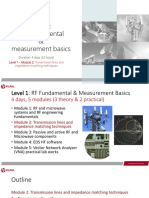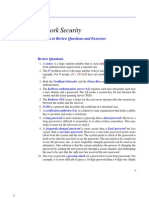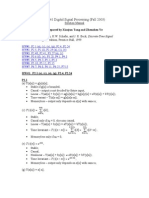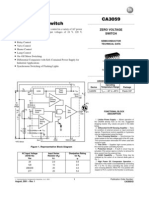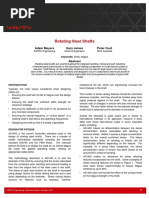Antenna Lab#3
Uploaded by
Xafran KhanAntenna Lab#3
Uploaded by
Xafran KhanCOMSATS Institute of Information Technology
Department of Electrical Engineering (Islamabad Campus)
Antenna Theory and Radio Waves Propagation
LAB # 3
Dipole Antennas
Lab Instructor: Bilal Tariq Malik Course Instructor: Adnan Iftikhar
Antenna Theory and Radio Wave Propagation
Spring 2012
Dipole Antennas
Note: Lab-2 is the pre-requisite of this Lab.
OBJECTIVE
This Lab is intended to show you how to Create, Simulate, and Analyze a Monopole and Dipole Antennas shown in Fig (1), using the Ansoft HFSS.
Fig (1): Dipole Antenna.
1 Lab-3. Dipole Antennas
Antenna Theory and Radio Wave Propagation
Spring 2012
Dipole Antenna:
A Dipole antenna is a radio antenna that can be made of a simple wire, with a centerfed driven element. It consists of two metal conductors of rod or wire, oriented parallel and collinear with each other (in line with each other), with a small space between them. The radio frequency voltage is applied to the antenna at the center, between the two conductors as shown in Fig: (1).
Design at f = 800MHz 1. Create Geometry of Dipole Antenna
Set Units Select the units mm. Set Material Select the material as Copper. Draw a Cylinder with Name: Pole1 Cylinder position X: 0.0 Y: 0.0 Z: 6.0 Draw a Cylinder with Name: Pole2 Cylinder position X: 0.0 Y: 0.0 Z: -6.0 Radius dX: 6.0 dY: 0.0 dZ: 0.0 Height dX: 0.0 dY: 0.0 dZ: -75.0 Radius dX: 6.0 dY: 0.0 dZ: 0.0 Height dX: 0.0 dY: 0.0 dZ: 75.0
To fit the view: Select the menu item View > Fit All > Active View
2 Lab-3. Dipole Antennas
Antenna Theory and Radio Wave Propagation
Spring 2012
2. Create Lumped Port Excitation
To set the Grid Plane: Select the menu item Modeler > Grid Plane > YZ Draw a rectangle with Name: Lumped Port Rectangle position X: 0 Y: -6.0 Z: -6.0 Opposite Corner dX: 0 dY: 12.0 dZ: 12.0
Fig (2): Lumped Port Excitation
3. Create Air
To set the default material: Using the 3D Modeler Materials toolbar, choose vacuum. Draw a box with Name: Air Box position X: -100 Y: -100 Z: -200 Opposite Corner dX: 200 dY: 200 dZ: 400
Fig (3): Air 3 Lab-3. Dipole Antennas
Antenna Theory and Radio Wave Propagation
Spring 2012
4. Create Radiation Boundary
a) To create a face list. Select the menu item Edit > Select > By Name. Select Object Dialog, o Select the objects named: Air o Click the OK button. Select the menu item HFSS > Boundaries > Assign > Radiation. Radiation Boundary window o Name: Rad1 o Click the OK button
5. Create a Radiation Setup
a) To define the radiation setup Select the menu item HFSS > Radiation > Insert Far Field Setup > Infinite Sphere Far Field Radiation Sphere Setup dialog. o Phi: Start: 0 Stop: 360 Step Size: 2 o Theta: Start: -180 Stop: 180 Step Size: 2 Click the OK button.
Analysis Setup
1. Creating an Analysis Setup
a) To create an analysis setup: Select the menu item HFSS > Analysis Setup > Add Solution Setup. Solution Setup Window: Solution Frequency: 800 MHz Maximum Number of Passes: 20 Maximum Delta S per Pass: 0.002
Click the OK button.
4 Lab-3. Dipole Antennas
Antenna Theory and Radio Wave Propagation
Spring 2012
2. Adding a Frequency Sweep
a) To add a frequency sweep: Select the menu item HFSS > Analysis Setup > Add Sweep. o Select Solution Setup: Setup1 o Click the OK button. Edit Sweep Window: o Sweep Type: Fast. o Frequency Setup Type: Linear Count. Start: 600 MHz Stop: 1000 MHz Count: 100 Save Fields: Checked. o Click the OK button.
Analyze
1. Model Validation
a) To validate the model: Select the menu item HFSS > Validation Check. Click the Close button. Note: To view any errors or warning messages, use the Message Manager.
2. Analyze
a) To start the solution process: Select the menu item HFSS > Analyze.
5 Lab-3. Dipole Antennas
Antenna Theory and Radio Wave Propagation
Spring 2012
REPORTS
1. Create Modal S-Parameter Plot - Magnitude
Create report (Modal S-Parameter Plot - Magnitude) of the Model.
Fig (4): S-Parameter Plot
2. Create Far Field Radiation Pattern
Create report (Far Field Radiation Pattern & 3-D Polar Plot) of the Model.
Ansoft Corporation
Radiation Pattern 2
0
HFSSDesign1
Curve Info dB(GainTotal) Setup1 : LastAdaptive Phi='0deg' dB(GainTotal) Setup1 : LastAdaptive Phi='90deg'
-30 -4.00
30
-18.00 -60 -32.00 60
-46.00
-90
90
-120
120
-150 -180
150
Fig (5): 2-D Radiation Pattern of Dipole Antenna. 6 Lab-3. Dipole Antennas
Antenna Theory and Radio Wave Propagation
Spring 2012
Fig (6): 3-D Polar Plot Dipole Antenna.
In-Lab Task:
Design a Dipole Antenna for f = 1800MHz and create Reports of the Model, also find out: Lower & Higher Frequencies Bandwidth of Antenna Max. Gain of Antenna Return loss at f=1800MHz Comparison of Radiation Patterns for f=800MHz & f=1800 MHz
Post- Lab Task:
Design a Dipole Antenna for (f = Reg. #/10) GHz and create Reports of the Model, also find out: Lower & Higher Frequencies Bandwidth of Antenna Max. Gain of Antenna Return loss at f= (Reg. #/10) GHz
7 Lab-3. Dipole Antennas
You might also like
- 1993 C/K Models Electrical Diagnosis and Wiring Diagrams80% (5)1993 C/K Models Electrical Diagnosis and Wiring Diagrams307 pages
- Antennas and Wave Propagation Nov 2007 Question Paper75% (4)Antennas and Wave Propagation Nov 2007 Question Paper8 pages
- Microwave Systems (10EC74) Assignment Set - 8No ratings yetMicrowave Systems (10EC74) Assignment Set - 83 pages
- MATLAB Solution To Microwave Engineering Pozar 4th Ed. Example 1.5No ratings yetMATLAB Solution To Microwave Engineering Pozar 4th Ed. Example 1.55 pages
- L1M2 - TL and Impedance Matching Techniques PDFNo ratings yetL1M2 - TL and Impedance Matching Techniques PDF41 pages
- Experiment No. - 1 (E) Objective:-To Measure The Antenna Characteristics For Yagi-Uda AntennaNo ratings yetExperiment No. - 1 (E) Objective:-To Measure The Antenna Characteristics For Yagi-Uda Antenna3 pages
- A Laboratory Manual Of: Antenna & Wave PropagationNo ratings yetA Laboratory Manual Of: Antenna & Wave Propagation29 pages
- Artificial Intelligence Based Antenna Design For Future Millimeter Wave Wireless Communication in Fifth GenerationNo ratings yetArtificial Intelligence Based Antenna Design For Future Millimeter Wave Wireless Communication in Fifth Generation6 pages
- Solution Manual Antenna Theory by Balanis Edition2 Chapter14bNo ratings yetSolution Manual Antenna Theory by Balanis Edition2 Chapter14b28 pages
- 6) Noise Characterization of A Microwave ReceiverNo ratings yet6) Noise Characterization of A Microwave Receiver17 pages
- AP UNIT 3 The Electric Dipoles and Thin Linear Antennas PDFNo ratings yetAP UNIT 3 The Electric Dipoles and Thin Linear Antennas PDF21 pages
- Unit 4: 1. Write Short Notes On Travelling Wave Antenna? AnsNo ratings yetUnit 4: 1. Write Short Notes On Travelling Wave Antenna? Ans14 pages
- GATE Problems in Antenna and Wave PropogationNo ratings yetGATE Problems in Antenna and Wave Propogation6 pages
- Mutual Coupling Reduction Techniques Between MIMO Antennas For UWB ApplicationsNo ratings yetMutual Coupling Reduction Techniques Between MIMO Antennas For UWB Applications5 pages
- In CST To Choose A Point That Lies in The Center Between Two PointsNo ratings yetIn CST To Choose A Point That Lies in The Center Between Two Points10 pages
- Microwave and Radar Engineering - M. KulkarniNo ratings yetMicrowave and Radar Engineering - M. Kulkarni113 pages
- Synopsis On Mathematical Model of Microwave Transmission100% (1)Synopsis On Mathematical Model of Microwave Transmission3 pages
- Network Security: Solutions To Review Questions and ExercisesNo ratings yetNetwork Security: Solutions To Review Questions and Exercises8 pages
- WWW and HTTP: Solutions To Review Questions and ExercisesNo ratings yetWWW and HTTP: Solutions To Review Questions and Exercises4 pages
- Process-to-Process Delivery:: Solutions To Review Questions and ExercisesNo ratings yetProcess-to-Process Delivery:: Solutions To Review Questions and Exercises6 pages
- Digital Signal Processing Solution Mannual Chapter Bonus Oppenheim100% (2)Digital Signal Processing Solution Mannual Chapter Bonus Oppenheim14 pages
- Telecommunication System Engineering Telephony Signal TransmissionNo ratings yetTelecommunication System Engineering Telephony Signal Transmission37 pages
- Projection of Line Contained by Plane Questions and Answers - SanfoundryNo ratings yetProjection of Line Contained by Plane Questions and Answers - Sanfoundry9 pages
- Analysis of Water Quality Parameters of Ground and Surface Water in Siltara Industrial Area, Raipur, Chhattisgarh, INDIA100% (2)Analysis of Water Quality Parameters of Ground and Surface Water in Siltara Industrial Area, Raipur, Chhattisgarh, INDIA8 pages
- No of List Use Construction Tools and Pieces of EquipmentNo ratings yetNo of List Use Construction Tools and Pieces of Equipment20 pages
- Analysis, Design and Estimation of Basement+G+2 Residential BuildingNo ratings yetAnalysis, Design and Estimation of Basement+G+2 Residential Building15 pages
- Methods For Construct Foundation in Collapsible SoilsNo ratings yetMethods For Construct Foundation in Collapsible Soils28 pages
- Optical Brinell Hardness Tester: Manual at Rs 95000/-Electrical at Rs 165000/ - Product DetailsNo ratings yetOptical Brinell Hardness Tester: Manual at Rs 95000/-Electrical at Rs 165000/ - Product Details1 page
- Flexural Design of Prestressed Beams Using Elastic Stresses ExampleNo ratings yetFlexural Design of Prestressed Beams Using Elastic Stresses Example5 pages
- IS - 5613 Part - 3 Code of Practice For Design Installation & Maintenance of Transmission Lines PDF75% (4)IS - 5613 Part - 3 Code of Practice For Design Installation & Maintenance of Transmission Lines PDF27 pages
- Aspec Paper - Rotating - Steel - Shafts PDFNo ratings yetAspec Paper - Rotating - Steel - Shafts PDF3 pages
- 1993 C/K Models Electrical Diagnosis and Wiring Diagrams1993 C/K Models Electrical Diagnosis and Wiring Diagrams
- Antennas and Wave Propagation Nov 2007 Question PaperAntennas and Wave Propagation Nov 2007 Question Paper
- MATLAB Solution To Microwave Engineering Pozar 4th Ed. Example 1.5MATLAB Solution To Microwave Engineering Pozar 4th Ed. Example 1.5
- Experiment No. - 1 (E) Objective:-To Measure The Antenna Characteristics For Yagi-Uda AntennaExperiment No. - 1 (E) Objective:-To Measure The Antenna Characteristics For Yagi-Uda Antenna
- A Laboratory Manual Of: Antenna & Wave PropagationA Laboratory Manual Of: Antenna & Wave Propagation
- Artificial Intelligence Based Antenna Design For Future Millimeter Wave Wireless Communication in Fifth GenerationArtificial Intelligence Based Antenna Design For Future Millimeter Wave Wireless Communication in Fifth Generation
- Solution Manual Antenna Theory by Balanis Edition2 Chapter14bSolution Manual Antenna Theory by Balanis Edition2 Chapter14b
- AP UNIT 3 The Electric Dipoles and Thin Linear Antennas PDFAP UNIT 3 The Electric Dipoles and Thin Linear Antennas PDF
- Unit 4: 1. Write Short Notes On Travelling Wave Antenna? AnsUnit 4: 1. Write Short Notes On Travelling Wave Antenna? Ans
- Mutual Coupling Reduction Techniques Between MIMO Antennas For UWB ApplicationsMutual Coupling Reduction Techniques Between MIMO Antennas For UWB Applications
- In CST To Choose A Point That Lies in The Center Between Two PointsIn CST To Choose A Point That Lies in The Center Between Two Points
- Synopsis On Mathematical Model of Microwave TransmissionSynopsis On Mathematical Model of Microwave Transmission
- Computer Aided Design of Electrical MachinesFrom EverandComputer Aided Design of Electrical Machines
- Modulation and Coding Techniques in Wireless CommunicationsFrom EverandModulation and Coding Techniques in Wireless Communications
- Network Security: Solutions To Review Questions and ExercisesNetwork Security: Solutions To Review Questions and Exercises
- WWW and HTTP: Solutions To Review Questions and ExercisesWWW and HTTP: Solutions To Review Questions and Exercises
- Process-to-Process Delivery:: Solutions To Review Questions and ExercisesProcess-to-Process Delivery:: Solutions To Review Questions and Exercises
- Digital Signal Processing Solution Mannual Chapter Bonus OppenheimDigital Signal Processing Solution Mannual Chapter Bonus Oppenheim
- Telecommunication System Engineering Telephony Signal TransmissionTelecommunication System Engineering Telephony Signal Transmission
- Projection of Line Contained by Plane Questions and Answers - SanfoundryProjection of Line Contained by Plane Questions and Answers - Sanfoundry
- Analysis of Water Quality Parameters of Ground and Surface Water in Siltara Industrial Area, Raipur, Chhattisgarh, INDIAAnalysis of Water Quality Parameters of Ground and Surface Water in Siltara Industrial Area, Raipur, Chhattisgarh, INDIA
- No of List Use Construction Tools and Pieces of EquipmentNo of List Use Construction Tools and Pieces of Equipment
- Analysis, Design and Estimation of Basement+G+2 Residential BuildingAnalysis, Design and Estimation of Basement+G+2 Residential Building
- Methods For Construct Foundation in Collapsible SoilsMethods For Construct Foundation in Collapsible Soils
- Optical Brinell Hardness Tester: Manual at Rs 95000/-Electrical at Rs 165000/ - Product DetailsOptical Brinell Hardness Tester: Manual at Rs 95000/-Electrical at Rs 165000/ - Product Details
- Flexural Design of Prestressed Beams Using Elastic Stresses ExampleFlexural Design of Prestressed Beams Using Elastic Stresses Example
- IS - 5613 Part - 3 Code of Practice For Design Installation & Maintenance of Transmission Lines PDFIS - 5613 Part - 3 Code of Practice For Design Installation & Maintenance of Transmission Lines PDF























